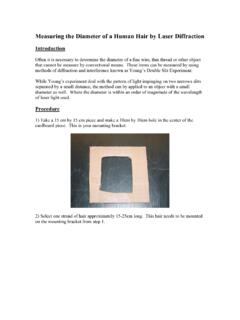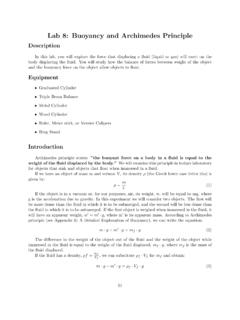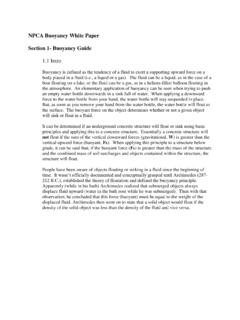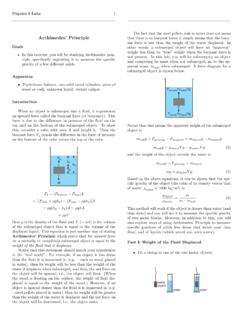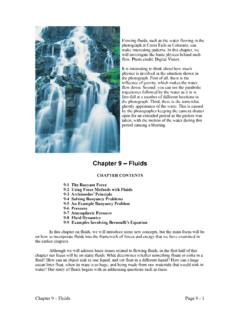Transcription of Gravity, Buoyancy, and the Stability of a Floating Object
1 gravity , buoyancy , and the Stability of a Floating Object Objective: to demonstrate the principal of buoyancy and archimedes Principle. archimedes Principle: any Object , wholly or partially immersed in a fluid, is buoyed up by a force equal to the weight of the fluid it displ aces or, more simply, Any Floating Object displaces its own weight of fluid. Question: As you add more weight to the vials, how will they float when you put them into a cup of water? What is the relationship between the weight of the vial and its volume? Materials: Gram scale*. 3 plastic vials with snap caps Small weights (dried beans, metal nuts, pennies, etc.). Clear plastic cup or beaker, or graduated cylinder Sharpie marker Water Syringe or pipette Ruler *A small electronic scale is best. Good, inexpensive scales can be purchased from The ProScale 600 Luxe costs about $30.
2 Procedure: 1. Label the vials with #1, #2 and #3. Fill vial one with a few pieces of weight, #2 with more, and #3 with still more. Cap them. 2. Weigh each vial and record the weight in a data table. 3. Fill the cup with water to about 2/3 full and mark the level of the fluid on the side of the cup with the marker, labeling it as base . 4. Place vial #1 in the cup making sure that it floats freely. Mark the level of the fluid in the cup by drawing a line with the #1 on the side. 5. Weigh the syringe and record its weight in the data table. 6. Using the syringe, carefully remove water from the cup until the level reaches the base measurement. 7. Weigh the syringe and record the weight in the data table. Also record the volume of the water you drew up into the syringe. 8. Put the water from the syringe back into the cup and add water, if necessary, to bring the level to the base measurement.
3 9. Repeat steps 4-8 for the other two vials. 10. Analyze your data. What does it tell you? Extensions: 1. What is the relationship between the volumes of water you drew up into the syringe and the weights of the water you drew up into the syringe? 2. What is the significance of the set of lines you drew on the side of the cup? 3. What are two ways in which you could determine the total volume of a vial? 4. How does this exercise relate to the story of archimedes ? 5. Add 4 grams of table salt to the water in the cup and stir to dissolve. Will this change the results of your experiment? How? Try it and see. 6. How might your data have differed if you used rubbing alcohol as the fluid instead of water? Now try answering these buoyancy Brainteasers*: buoyancy Question Here we have a toy submarine Floating in a bathtub. It's a really fancy sub, made out of steel.
4 The sub weighs one pound. When completely submerged, it displaces two pounds of water. What could you do to cause the sub to sink to the bottom of the tub? Add one pound of sand to the sub's interior. Add one pound of sand to the sub's interior, plus a little more. Nothing. Since the boat displaces more water than it weighs, it's already on its way down. Boat-in-Pool Puzzler Here we have a boat in a swimming pool. In the boat is an inquisitive experimenter. Also in the boat is a rock. Our experimenter picks up the rock and tosses it into the pool. The rock sinks to the bottom. No water leaves the pool from the splash made by the rock. Now for the question: Does the pool's water level rise, lower, or stay the same? The water level rises. The water level lowers. The water level stays the same. Balloon-in-Car Puzzler You're sitting in a car that's not moving.
5 Also in the car is a helium-filled balloon, which is resting up against the car's ceiling somewhere near its middle. The driver hits the gas and the car accelerates forward. You're thrown back into your seat. What happens to the balloon? (Before you answer, think about what will make the balloon act the way you think it will.). It floats toward the back of the car. It floats toward the front of the car. It stays put. * taken from Objective: to show how the spatial relationship of the center of gravity to the center of buoyancy can affect the Stability of a boat. Center of gravity : the average location of the gravitational force acting on an Object . Center of buoyancy : the center of the volume of water a Floating Object displaces. Question: As you move the center of gravity of a boat further away from the center of buoyancy , what happens to the Stability of the boat?
6 Materials: Bowl or pan to hold water Disposable paper cups, weigh boats, or toy boats Modeling clay Straws Water Procedure: 1. Fill the pan halfway with water. 2. If using disposable paper cups, cut them off to about 1 high. Press some modeling clay into the bottom of your boat and float your boat in the pan of water. Make sure that it floats stably. 3. Cut a straw in half and stick it upright in the clay as close to the center of the boat as possible. 4. Take a small amount of modeling clay and roll it to m ake a ball. Place the ball of clay at different positions on the straw. Check the tipability of the boat. Think about your observations. Where is the center of buoyancy of your boat? Does it change as your boat keels over? Explain the relationship between the spatial location of the centers of buoyancy and gravity as they relate to the Stability of the boat.
7 Resource Websites: This site has a thorough and easily understandable explanation of Stability and the center of buoyancy / gravity , complete with Flask animations. An excellent resource that lets students play with a buoyancy simulator to develop understandings of weight, volume and density and how they relate to buoyant force. Standards Compliance Content Level Content Standard K-4 5-8 9-12. Science as Inquiry - A . Physical Science B . Life Science C. Earth & Space Science - D . Science & Technology - E. Science in Personal and Social Perspective - F. History and Nature of Science - G.

